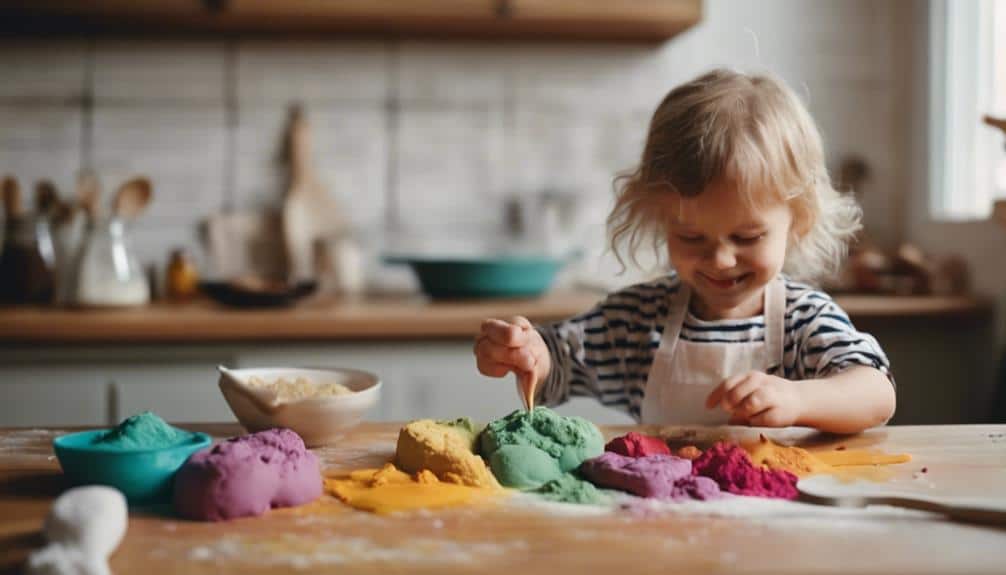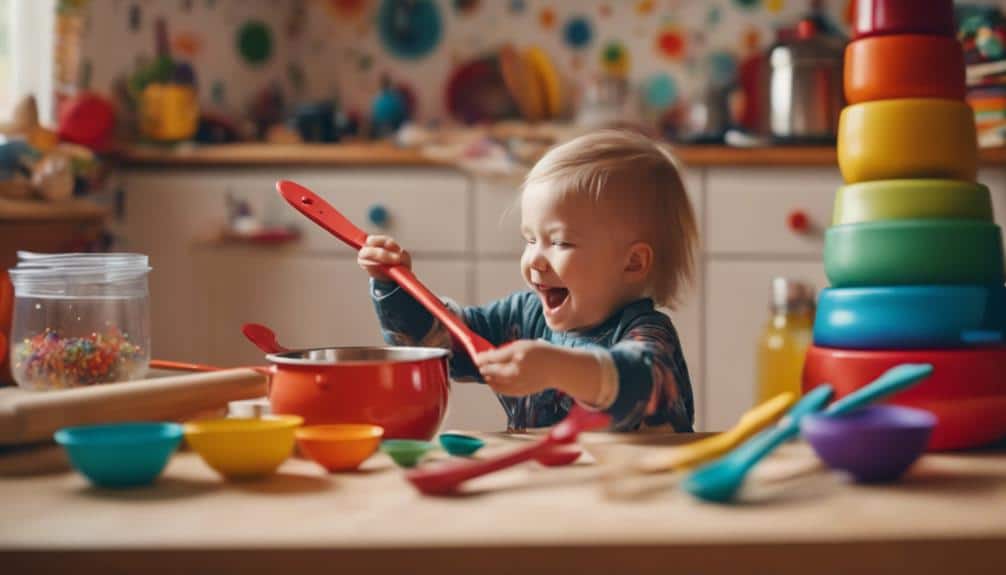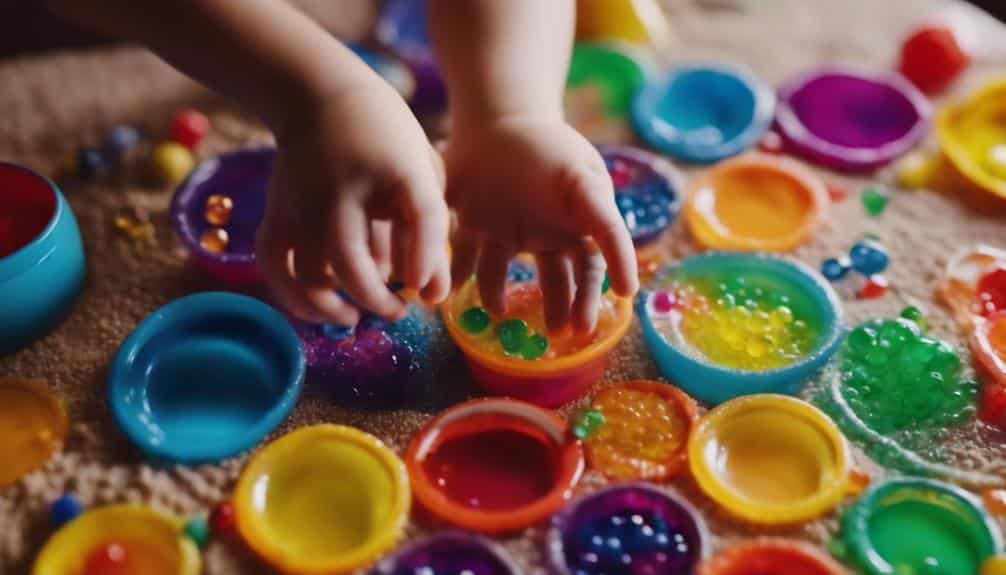Sensory play is a pivotal component of early childhood development, offering myriad benefits from fine motor skill enhancement to cognitive growth. ‘Sensory Play Ideas for Toddler Growth’ meticulously outlines activities designed to engage toddlers’ senses, fostering an environment of exploration and discovery. Whether it’s the tactile pleasure of homemade playdough or the auditory delights of sound and music fun, this guide equips parents and caregivers with the knowledge to create enriching sensory experiences.
However, the importance of safety and customization in meeting individual child needs are considerations that cannot be overlooked. As we proceed, one might find themselves intrigued by the potential transformations in a child’s learning journey through the strategic integration of sensory play.
Key Takeaways
- Sensory play boosts toddlers’ cognitive growth, fine motor skills, and sensory integration.
- Always supervise toddlers during sensory play to ensure their safety.
- Choose non-toxic, natural, and child-friendly materials for sensory activities.
- Incorporate diverse activities like crafting sensory bins and homemade playdough-varied sensory experiences.
Understanding Sensory Play
Sensory play, an essential component of early childhood development, engages multiple senses simultaneously, fostering cognitive growth, fine motor skills, and sensory integration in toddlers. By stimulating sight, touch, smell, taste, and sound, sensory activities encourage children to explore and understand the world around them, comprehensively nurturing their development. This form of play is vital for enhancing sensory processing abilities and promotes balance, body awareness, and essential communication skills, laying a solid foundation for future learning and interaction.
Incorporating sensory play into daily routines can be seamlessly achieved through various activities like sand play, music, and singing, which are enjoyable for the toddler and beneficial for their overall development. These experiences allow children to experiment with different textures, sounds, and smells, catalyzing their curiosity and eagerness to learn. The benefits of sensory play are manifold, including the enrichment of cognitive processes, the refinement of motor skills, and the improvement of problem-solving abilities.
Caregivers can significantly contribute to their exploratory learning and developmental milestones by providing children with opportunities to engage in sensory play, ensuring a well-rounded growth trajectory.
Essential Safety Tips
As we explore sensory play ideas for toddlers, prioritizing safety is paramount to fostering a secure and enriching environment. Selecting non-toxic materials, ensuring constant supervision, and being aware of allergies are foundational to safeguarding our young learners. These essential safety tips protect toddlers’ well-being and enhance their sensory play experience by creating an atmosphere of trust and exploration.
Choosing Non-Toxic Materials
When selecting materials for toddler sensory play, prioritizing non-toxic options is crucial for their safety and well-being. For guardians and educators dedicated to fostering a secure and enriching environment, understanding the significance of choosing safe materials cannot be overstated. Look for labels that indicate products are non-toxic, and seek out the ASTM D-4236 certification on art supplies, verifying they’ve been assessed for toxic substances.
Opting for natural and organic options whenever possible is advisable to protect young learners from harmful chemicals such as lead, phthalates, or BPA. Emphasizing water-based, washable, and child-friendly products ensures toddlers’ safety during sensory play and supports a healthy, development-focused exploration of their world.
Supervision Is Key
In ensuring the safety and well-being of toddlers during sensory play, vigilant supervision is indispensable to mitigate risks and foster a secure learning environment. Supervision guarantees safety and enables toddlers to explore and learn confidently. To paint a clear picture, consider the following essential tips:
- Constant Presence: Always be within arm’s reach to prevent accidents and provide immediate help.
- Interactive Guidance: Actively engage with toddlers, guiding their exploration to ensure safety while encouraging learning.
- Risk Assessment: Continuously evaluate the play area and materials for potential hazards, intervening promptly to remove any risks.
Allergy Awareness Importance
Recognizing the importance of allergy awareness is paramount in safeguarding toddlers during sensory play activities. Allergies can be life-threatening, demanding prompt and knowledgeable responses, especially in the face of an anaphylaxis attack—a severe allergic reaction triggered by allergens. Common allergens such as peanuts, tree nuts, dairy, eggs, soy, wheat, fish, and shellfish can lurk in unexpected places, underscoring the significance of vigilance against cross-contamination.
This vigilance extends to meticulously reading food labels, inquiring about ingredients, and fostering a culture of ingredient awareness. Emergency plans tailored to manage allergic reactions are indispensable, ensuring a swift, effective response. By integrating these practices, caregivers can create a safer, more inclusive environment for sensory play, prioritizing the well-being of every toddler.
Crafting Sensory Bins
Crafting sensory bins offers an innovative way to support toddlers in exploring and developing sensory processing skills. By introducing sensory bins, caregivers and educators can create a dynamic environment that fosters hands-on exploration, stimulates creativity, and promotes independent play. These bins can be easily themed, making them a versatile tool for sensory exploration that resonates with toddlers’ interests and developmental stages.
To paint a picture of how sensory bins can be integrated into a toddler’s play routine, consider the following:
- Seasonal Sensory Bins: Fill a bin with items related to a particular season, such as colored leaves in autumn or snow-like substances in winter, to stimulate sensory exploration and understanding of the world.
- Color and Texture Exploration: Use sensory-safe materials like rice, beans, or water beads dyed in different colors to encourage toddlers to explore and differentiate textures and hues.
- Creative Play Prompts: Incorporate elements that inspire creativity, such as miniature figures or construction tools, allowing toddlers to craft their narratives during independent play.
Homemade “Playdough”

Delving into the world of homemade play dough offers toddlers an enriching opportunity to engage in sensory play while enhancing their fine motor skills through the creative manipulation of this versatile material. Homemade play dough is a cost-effective alternative to store-bought options, allowing endless customization in colors, scents, and textures. This makes it an ideal tool for fostering toddlers’ sensory exploration and fine motor skills development.
Here’s a brief overview of simple ingredients commonly used in homemade playdough:
| Ingredient | Purpose |
|---|---|
| Flour | Base |
| Salt | Texture |
| Water | Moisture |
| Oil | Elasticity |
| Food Coloring | Colors |
Water Exploration Activities
Water exploration activities offer toddlers a dynamic platform to enhance their sensory skills through immersive experiences with touch and sight. Engaging toddlers in water play is not only about splashing around; it’s a critical pathway to fostering their development in key areas like hand-eye coordination and fine motor skills. With a blend of fun and learning, these activities provide a versatile sensory experience that can be adapted for indoor and outdoor settings.
To paint a vivid picture for those passionate about nurturing the growth of young ones, consider the following activities:
- Water Tables: These can be filled with various objects for toddlers to scoop, pour, and explore, promoting tactile and visual sensory development under careful supervision.
- Splash Pads: Offering a more dynamic and physically engaging form of water play, splash pads stimulate motor skills and coordination, making every moment of play a developmental opportunity.
- Water Play Areas: Specifically designed areas that incorporate different textures and water flows encourage toddlers to explore and understand the properties of water, enhancing sensory exploration.
Incorporating these water-based activities into a toddler’s playtime ensures a balanced approach to their sensory development, making every splash and giggle a step toward growth under the essential supervision umbrella.
Sound and Music Fun

Moving beyond tactile sensations, engaging toddlers in sound and music activities opens a new avenue for auditory stimulation and developmental growth. These activities delight the auditory senses and serve as a cornerstone for fostering creativity and imagination in young minds. By turning everyday items such as pots, pans, and homemade instruments into tools for interactive play, parents and educators can create a rich tapestry of sensory experiences that are both fun and educational.
Introducing toddlers to rhythm and movement through music encourages them to explore the world of sounds in a structured yet playful manner. This approach enhances their sensory experiences and supports their development by integrating auditory learning with physical activity. As children tap, shake, and create music, they are not just making noise but are actively participating in a process that nurtures their imagination and encourages creative expression.
Textural Art Projects
As we transition to textural art projects in sensory play, it’s essential to prioritize safety and organization. Choosing safe materials ensures that toddlers can explore textures like smooth, rough, and bumpy without risk while setting up dedicated spaces that foster a structured environment for creativity. Furthermore, incorporating easy cleanup tips will facilitate a more enjoyable and sustainable art experience for children and caregivers.
Choosing Safe Materials
Selecting non-toxic and child-safe materials is crucial when planning textural art projects for toddlers, ensuring their safety while fostering sensory exploration. For those dedicated to serving the developmental needs of young children, here’s how to choose wisely:
- Variety of Textures: Incorporate materials that offer a range of tactile experiences, such as smooth pebbles, rough sandpaper, soft feathers, and hard shells. This diversity stimulates different sensory receptors.
- Natural and Washable: Opt for natural materials like sand, fabric, and feathers, ensuring they are washable to maintain a safe environment.
- Non-Toxic Assurance: Always choose materials that are explicitly labeled non-toxic and safe for children’s use, safeguarding them from potential harm during sensory activities for toddlers.
Setting Up Spaces
After ensuring safe and non-toxic materials are used for textural art projects, organizing and preparing spaces where toddlers can freely explore these sensory experiences is essential. Setting up an inviting and well-organized area dedicated to sensory activities involving textures allows children to engage their tactile senses effectively. By providing various materials like sand, fabric, yarn, buttons, and paint, toddlers can experience a spectrum from smooth to rough sensations.
These textural art projects foster creativity and fine motor skills and enhance sensory processing and awareness. Creating such an environment encourages toddlers to express themselves and explore the world around them through the richness of textures, making learning both enjoyable and impactful.
Easy Cleanup Tips
Engaging toddlers in textural art projects like finger painting and playdough ignites their sensory exploration but necessitates efficient cleanup strategies to maintain a conducive learning environment. These activities offer tactile sensations crucial for developing and enhancing fine motor skills. To facilitate easy cleanup:
- Utilize washable paints and materials, ensuring any mess can be swiftly washed away.
- Prepare the workspace by covering surfaces with plastic tablecloths or old newspapers, protecting the area from spills and stains.
- Encourage wearing a smock or old clothes and provide clear instructions and boundaries. This will help toddlers understand the limits and focus on their creative process, minimizing potential messes.
Incorporating Nature
Incorporating natural elements into sensory play activities offers toddlers a rich opportunity to explore the diverse textures, scents, and sounds of the outdoors, fostering a deep connection with the environment. Nature-inspired sensory activities, such as gathering leaves, sticks, and rocks, enable children to touch, smell, and listen to the unique aspects of their surroundings. This outdoor sensory play stimulates toddlers’ senses and promotes a profound connection to the natural world.
Toddlers can interact with various natural materials by engaging in activities like nature walks, creating sensory gardens, or embarking on outdoor art projects. These interactions enhance their sensory experiences, encouraging curiosity and exploration. The calming and grounding sensory experience provided by being in nature supports toddlers’ emotional well-being and development.
Through these nature-based activities, children learn to appreciate the beauty and complexity of the environment, laying the foundation for lifelong stewardship and respect for nature. Parents and educators can create meaningful and enriching experiences that stimulate, educate, and nurture young minds by integrating natural elements into sensory play.
Frequently Asked Questions
What are some engaging Sensory Play Ideas for toddlers?
To set up a sensory play for toddlers, select a safe, supervised area and utilize non-toxic, age-appropriate materials. Incorporate diverse textures, colors, and scents, rotate items regularly, and engage interactively to enrich the learning experience.
What Are Some Examples of Sensory Play?
Sensory play, a gateway to exploration, includes sensory bins, water play, and playdough experiences that strengthen cognitive development, creativity, and motor skills. These enrich toddlers’ learning landscapes through engaging, hands-on exploration.
What Is Open-Ended Sensory Play for Toddlers?
Open-ended sensory play for toddlers is a form of exploration that encourages children to engage their senses without predefined outcomes. It fosters creativity, problem-solving skills, and independent thinking while supporting language and social development.
What Are the Sensory Patterns for Toddlers?
Sensory patterns for toddlers typically involve diverse repetitive interactions, such as touching and listening. These patterns, reflecting a child’s unique sensitivities and preferences, are crucial for their cognitive and emotional development.
Conclusion
Sensory play activities are a fun opportunity for children to engage their senses and promote sensory development. For babies aged 0-18 months, sensory play can involve simple activities using household items such as a plastic container of water, a sensory bottle filled with colorful liquids, or a sensory tray with various textures. These activities help babies explore their sense of touch, sense of movement, and sense of hearing while also promoting hand-eye coordination and motor skill development.
Toddlers can engage in sensory play experiences such as playing with kinetic sand, blowing bubbles, or exploring a sensory table with items like cotton balls, ice cube trays, and squishy balls. These activities provide a lot of fun and support cognitive development, language skills, and social interactions. Additionally, outdoor activities like water-related activities or playing in a ball pit can further enhance their physical growth and observational skills.
Childcare providers and parents can create sensory play ideas using items like bubble wrap, egg cartons, and colorful paints to provide a rich sensory experience for kids. These hands-on activities promote emotional skills, listening skills, and language development while encouraging active toddlers to explore and learn.


Recent Comments